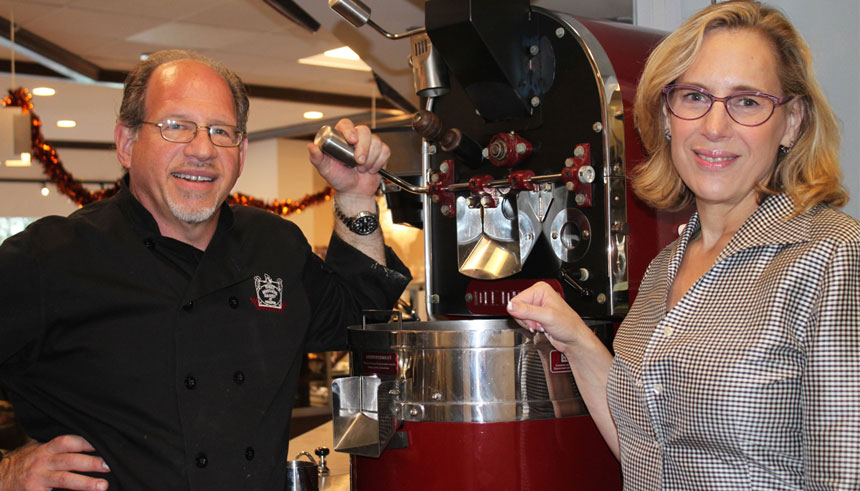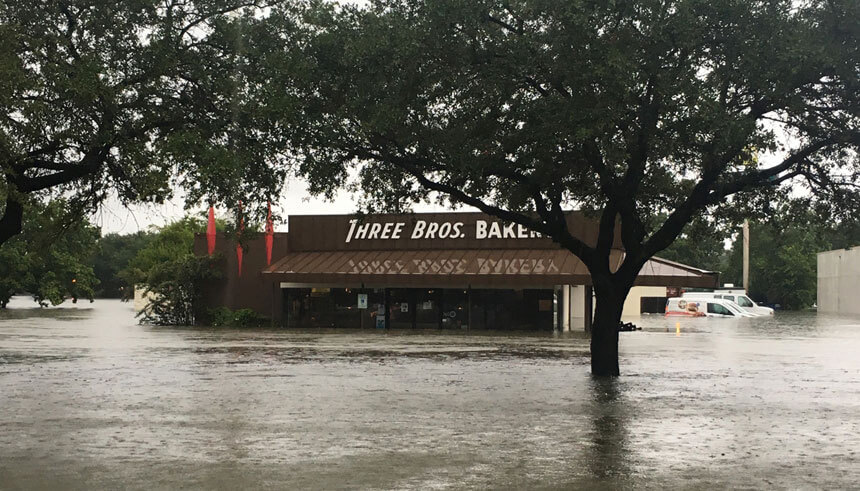Insights
SBA Disaster Loans Help Businesses Weather the Economic Storm
By Vickie An

In the aftermath of a declared disaster, SBA disaster loans can help business owners get back on track.
Bobby and Janice Jucker, owners of the popular Three Brothers Bakery in Houston, Texas, have built a name for themselves creating award-winning pies, cookies and cakes. But these days, they’ve gained a reputation for something else too—being experts at surviving catastrophes.
In the past 10 years alone, the couple has had to rebuild the bakery’s South Braeswood location, a neighborhood fixture since 1960, time and time again after repeated disasters. In 2008, the force of Hurricane Ike’s 110 mph winds damaged the roof so badly that the building and production areas were rendered inoperable, forcing them to close for nine months to make repairs. There was also the time the shop took on 3 feet of water during the 2015 Memorial Day Flood, only to sustain water damage again the following April with the 2016 Tax Day Flood, not to mention a fire in the main freezer later that year. And before all of that, in 2001, flooding from Tropical Storm Allison had shuttered the bakery for three days.
Then came Harvey. The Category 4 hurricane barreled into the Gulf Coast on August 25, 2017, unloading historic amounts of rainfall—more than 60 inches over parts of the Lone Star State—in four days. By the time the deluge ended, large swaths of Houston were underwater, including the Braeswood area, where 4½ feet of murky floodwater had inundated Three Brothers Bakery’s retail store and production facility. It was the worst flooding the city—and the store—had ever seen.
“We just laughed. We’re like, here we go again,” recalls Janice of their reaction upon seeing a photo of the bakery from the outside, submerged in brown water. The Juckers had just arrived in Pagosa Springs, Colorado, for a rare bit of R&R when Harvey made landfall in Texas. It was hard to relax knowing what awaited them back home. They spent much of their vacation glued to the TV. “We knew it was going to be bad, but I don’t think we understood how bad,” Janice says.
However, because they’d been through it all before, the self-proclaimed “King and Queen of Disaster” already had a reliable emergency preparedness plan to get things up and running as quickly as possible once they were able to get back into town five days later—and that included applying for a disaster loan from the U.S. Small Business Administration (SBA).

Who’s eligible for an SBA disaster loan?
When it comes to seeking recovery assistance in the aftermath of a federally declared disaster—be it a hurricane, tornado, earthquake, wildfire or other catastrophe—the SBA isn’t the first government agency that typically pops to mind. But what many people don’t realize is that they offer support to those impacted by declared disasters too, in the form of low-interest, long-term disaster loans.
Despite being administered by the SBA, federal disaster loans aren’t just limited to small businesses. Enterprises of all sizes (including those in the process of launching), not to mention private nonprofit organizations, homeowners and renters, can apply for assistance if they’ve suffered losses as a result of a declared disaster.
In particular, two main types of SBA disaster loans are available to businesses: physical disaster loans, which can be used to repair or replace damaged real estate, equipment, inventory and fixtures; and economic injury disaster loans, which are working capital loans that can be used to cover various operating expenses until normal operations resume. To qualify, business owners still need to show credit-worthiness and an ability to repay the loan, just as they would in any other lending situation.
Both of these loans go up to $2 million. The terms vary by disaster, but in general, for businesses that don’t have additional sources of credit, the loans carry a fixed interest rate of no more than 4 percent, with up to a 30-year amortization schedule. For those that do have credit available elsewhere, the fixed interest rate will not exceed 8 percent.
[Also read: How One Business Turned a Disaster into Successful Growth]
In any case, the terms of an SBA disaster loan are generally more favorable than a conventional loan, explains Tim Jeffcoat, district director of the SBA Houston District Office. Although, he says, “We would love it if small businesses never had to borrow from us.” Instead, Jeffcoat recommends owners acquire an insurance policy that can help their business recover without having to incur additional debt.
“We really view disaster funding as a last resort,” he adds. “With that said, it happens frequently that businesses need it, and when they do, we want to make sure they get the best terms so that it can be affordable to assist them in recovery.”
An unprecedented storm
The SBA assisted thousands of businesses in Houston after the destruction laid out by Harvey. The district office received 12,642 applications for disaster loans. Of those, 3,906 applicants were approved, including the Juckers, amounting to just over $450 million in loans issued by the SBA for disaster recovery. Jeffcoat is quick to point out that this doesn’t necessarily mean the rest were declined—some applicants may have chosen not to proceed.
The Juckers were approved for nearly $800,000 in SBA disaster loans, and they credit the funds for helping to keep Three Brothers afloat in the storm’s immediate aftermath. The flooding destroyed the bakery’s interior, equipment and perishable inventory. It also wrecked two delivery vans. Because the Braeswood outpost also services the bakery’s two other locations in the Memorial and Washington Avenue districts, those stores took an economic hit, as well.
It took 17 days to clean up the shop and get everything functioning again, a fairly quick turnaround considering some businesses took several months to reopen. Fortunately, they had built up their cash reserves enough to pay their 65 employees throughout the entire closure. That’s the best-case scenario when you’re prepared.
The Juckers became aware of the brewing storm two days before Harvey made landfall. As they drove to Colorado, Janice called both the restoration company and the flood adjuster they’d hired previously, a cautionary measure she began taking after the 2015 flood. She wanted to be first in line for their services in the event the shop flooded again. “[Doing] those types of things really make your recovery much faster,” she explains. “When the storms are in the Gulf, I call these people and put them on notice.”
Once they got back into town, everyone knew their role. Bobby traveled the country gathering replacement equipment and vans. The bakery’s general manager and employees took care of the physical cleanup; Janice handled the financials, which meant making insurance claims and collecting the necessary paperwork to apply for the SBA disaster loans, including tax returns and other financial statements from the last few years for each of their business entities. Roughly 10 days after the storm hit, she headed to her local small business development center (SBDC) for help with the loan application.
“I don't think it ever occurred to us not to reopen,” says Janice. But she does admit, somewhat wearily, that she’s not sure how many more disasters they can take. So, they also applied for and received an SBA loan to relocate their bakery to higher ground.
Their efforts didn’t go unnoticed. In April 2018, Three Brothers Bakery received the SBA Phoenix Award for Outstanding Small Business Disaster Recovery. In a year that witnessed so many catastrophic events—among them Hurricanes Irma, Harvey and Maria, and two major wildfires—the Juckers stood apart by “how quickly and completely they were able to recover, and keep their people employed,” Jeffcoat notes.
The award, Janice jokes, “is one you never want to qualify for!” But it does give them extra credibility as experts in small business disaster recovery, something that’s advantageous when lobbying lawmakers for change, she says.
Small businesses often get left behind during disasters, as the focus tends to center on getting people back in their homes or apartments, she says. That’s obviously important, she adds, but the problem is they still have to pay rent, mortgage and other bills. None of that can happen if their employer goes out of business. The Juckers hope that by winning the Phoenix Award, they can shed light on the issue and also encourage people to shop small businesses in disaster zones.
Preparation is key
The best advice the Juckers can offer to other business owners is to prepare well in advance with an emergency disaster plan, says Janice. She offers these general tips:
- Know your insurance policy inside and out, before you ever need to use it.
- Have employee contact information (as well as other important records) readily accessible in the cloud so you can account for everyone during an emergency.
- Keep financial documents in order at all times to make it easier when it comes time to apply for a loan. “You don’t want to be doing your finances while trying to manage a disaster,” Janice reasons.
- Keep a running list of alternative suppliers to replace equipment or inventory.
- Always have cash. “The one thing we learned from Harvey more than any of the other disasters is that if you do not have cash, there is no reason to muck out your business, because you're not going to make it,” she says. “You can charge practically everything else, but you cannot pay your employees with a credit card. That takes cash.”
Jeffcoat agrees. “The most important thing is that a business takes some time to be ready for whatever they can conceive as the worst happening,” he says. “That sounds simple, but once the disasters are behind us, people tend not to think about it anymore.”
[Also read: SBA Loans 101: Frequently Asked Questions]
If you need help putting together a disaster plan for your business, Jeffcoat suggests contacting your local SBDC for assistance. The SBA Houston District Office also partners with the American Red Cross several times a year to conduct workshops on emergency preparedness.
In terms of financial recovery, Janice says, “we’re still not quite there.” But they’re hoping that by rebranding and spending more on marketing, they’ll be able to draw in more revenue. They are survivors, after all.
Her final piece of advice for coming through a disaster: “Keep your cup half full, not half empty—mine’s always half full.”

